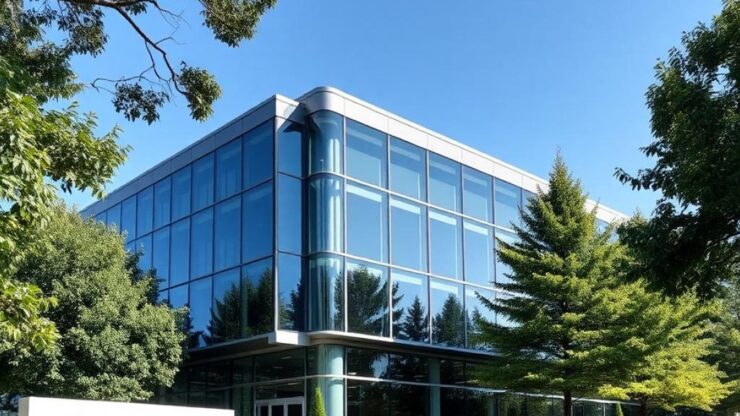Understanding the Basics of Commercial Property Insurance
What is Commercial Property Insurance?
Commercial Property Insurance is a vital component for businesses of all sizes, providing essential coverage for physical assets. This type of insurance safeguards your business against loss or damage to buildings, equipment, inventory, and even outdoor fixtures due to a variety of risks. Understanding this insurance is crucial for any business owner who wants to mitigate potential financial losses.
Key Coverage Areas to Consider
When evaluating Commercial Property Insurance, it’s important to be aware of the various coverage options available. Each business has unique needs that require tailored policies to ensure complete protection. Below is a list of key coverage areas that can be included in a Commercial Property Insurance policy:
- Building Coverage: Protection for the physical structure of your business.
- Contents Coverage: Insurance for furniture, equipment, and inventory within the premises.
- Business Interruption: Coverage that compensates for lost income during downtime due to covered events.
- Equipment Breakdown: Protection against mechanical failures affecting business operations.
- Outdoor Property: Coverage for items like signage, fencing, and landscaping.
How to Choose the Right Policy
Selecting the right Commercial Property Insurance policy can be overwhelming due to the myriad of options available. Here are several steps to guide you through the process:
- Assess Your Needs: Evaluate what assets need protection and the potential risks associated with your business operations.
- Compare Policies: Look for policies from various insurers, comparing coverage limits, deductibles, and exclusions.
- Consult with Experts: Engage with insurance brokers or agents who specialize in commercial coverage. Their expertise can help you make informed decisions.
- Review Regularly: As your business grows or changes, revisit your policy to ensure it remains relevant and adequate.
Key Coverage Options for Business Assets
When it comes to safeguarding your enterprise, understanding the key coverage options available under Commercial Property Insurance is essential. These options are designed to address the specific risks that businesses face, allowing you to tailor a policy that provides comprehensive protection for your unique assets. Knowing these coverage areas can empower business owners to make informed decisions that enhance their financial security.
One of the most critical components of Commercial Property Insurance is Building Coverage. This coverage not only protects the physical structure of your business but also includes additional structures on your property, such as garages or storage units. Should a disaster strike—be it fire, vandalism, or natural calamities—having robust building coverage ensures that the expenses related to repairs or rebuilding are covered, allowing you to resume operations with minimal disruption.
In addition to building coverage, Contents Coverage plays a pivotal role in your overall insurance strategy. This coverage extends to the tangible assets within your premises, such as office furniture, machinery, and inventory. It’s crucial to assess the value of these items accurately, as underestimating can lead to inadequate compensation in the event of a loss. Furthermore, understanding the exclusions—such as wear and tear or certain types of equipment damage—will help you navigate your policy effectively.
Business operations can be significantly impacted during unforeseen events, which is where Business Interruption Insurance comes into play. This coverage is often a lifeline for businesses, providing financial support for lost income while operations are temporarily halted due to covered incidents. It is vital to evaluate the anticipated duration of downtime and the extent of your financial requirements to select an appropriate coverage limit that reflects your business’s unique needs.
When considering these coverage options, engaging with an insurance professional can provide invaluable insights. They can assist in comparing various policies and understanding the nuances of each coverage type, which is especially important given the complexity of commercial insurance. Regularly reviewing your policy ensures that as your business evolves, your coverage remains suitable and comprehensive.
Factors Influencing Insurance Premiums
When securing Commercial Property Insurance, understanding the factors that influence insurance premiums can significantly impact your financial planning. Insurance premiums are not one-size-fits-all; they are determined by a variety of elements that reflect the unique risks associated with your business. By grasping these factors, business owners can make informed choices that not only enhance their coverage but also potentially lower their costs.
The Role of Location and Environment
The geographical location of your business plays a pivotal role in determining your insurance premiums. Areas prone to natural disasters such as floods, earthquakes, or hurricanes often see higher premiums due to the increased risk of property damage. Additionally, the surrounding environment, including crime rates and local fire department ratings, can also impact costs. Understanding how these elements affect your insurance can guide your decision-making process in securing the right policy.
Building Characteristics and Security Measures
The characteristics of the building housing your business can significantly influence your insurance premiums. Factors such as the age of the building, construction materials, and fire safety features all come into play. For instance, a building constructed with fire-resistant materials may attract lower premiums compared to older structures. Moreover, implementing robust security measures, like surveillance systems or alarm systems, can lower the risk profile of your business, resulting in potential discounts on your premiums.
Type of Business and Coverage Needs
The nature of your business and the specific assets you wish to insure will also affect your premiums. High-risk industries, such as manufacturing or construction, typically face higher premiums compared to low-risk sectors like consulting. Furthermore, the level of coverage you choose—be it basic or comprehensive—will directly influence your premium costs. Below is a list of key factors that insurers typically evaluate when calculating premiums:
- Business Location: Risk of natural disasters, crime rates.
- Building Age: Older buildings generally incur higher rates.
- Construction Type: Fire-resistant materials may lower premiums.
- Security Features: Enhanced security systems can lead to discounts.
- Industry Risk Level: Higher risk industries face higher premiums.
- Coverage Amount: More extensive coverage leads to increased costs.
In conclusion, being aware of these factors can empower business owners to take proactive steps in managing their insurance costs while ensuring that they have adequate protection for their assets. Engaging with an insurance professional can provide additional clarity and assist in navigating the complexities of insurance premiums, ultimately leading to better decisions for your business’s financial health.
The Claims Process: What to Expect
Understanding the claims process is essential for business owners who have invested in Commercial Property Insurance. Often, the aftermath of a loss or damage can be overwhelming, but knowing what to expect can alleviate some of the stress involved. The claims process is not just a formality; it is a critical avenue for recovering losses and ensuring business continuity. This section will guide you through the steps involved, empowering you to navigate this process with confidence.
The Initial Steps Following a Loss
When an incident occurs that necessitates filing a claim, the first step is to notify your insurance provider as soon as possible. This quick communication can expedite the claims process and provide you with immediate guidance on the next steps. Be prepared to provide detailed information about the incident, including the date, time, location, and a description of the damages or losses sustained. It is important to remain as factual and objective as possible, as this information will be crucial in determining the validity of your claim.
Documentation: The Key to Successful Claims
One of the most vital aspects of the claims process is documentation. Insurers will require proof of the loss or damage, which may include photographs, receipts, and inventory lists. Keeping organized records of your property and its value prior to an incident can significantly ease this process. In addition, you may need to complete specific claim forms provided by your insurer. Thoroughness and accuracy in these documents can directly impact the outcome of your claim, ensuring you receive the compensation you are entitled to.
Once your claim is submitted, the insurer will assign a claims adjuster to assess the situation. This professional will conduct an investigation, which may involve site visits, interviews, and further documentation requests. Maintaining open communication with the adjuster is essential, as they will be your point of contact throughout the process. Their evaluation will ultimately determine the amount of compensation awarded.
Understanding the Timelines and Potential Outcomes
While the timeline for claims processing can vary, most insurers aim to resolve claims promptly. However, complexities can arise depending on the nature of the loss and the thoroughness of the documentation provided. It’s advisable to manage your expectations and prepare for possible delays. If your claim is accepted, the insurer will issue a payment based on the terms of your policy, which can help you recover from the incident. In cases where claims are denied or insufficiently compensated, business owners have the right to appeal the decision or seek mediation to address disputes.
Ultimately, understanding the claims process not only prepares you for potential future incidents but also reinforces the importance of maintaining comprehensive records and open communication with your insurance provider. A proactive approach can enhance your experience, ensuring that your business assets are adequately protected and that you can focus on what matters most—running your business.
Best Practices for Choosing the Right Policy
Selecting the right Commercial Property Insurance policy is a pivotal step in safeguarding your business assets. This nuanced process requires more than just a cursory glance at policy offerings; it demands a thorough understanding of your unique business needs and the coverage options available. By employing best practices in policy selection, business owners can ensure that they are not only adequately protected but are also making informed financial decisions that promote long-term stability.
Unearthing Your Business Needs
The first step towards choosing the ideal policy is a comprehensive assessment of your business’s specific needs. This involves evaluating the nature of your operations, the assets you wish to insure, and the potential risks you may encounter. For instance, if you operate in a high-risk area prone to natural disasters, your policy will need to reflect this vulnerability. Additionally, consider how your business model influences your coverage requirements. A retail operation, for example, may prioritize inventory protection, while a tech startup may need to focus on equipment coverage. By identifying these key areas, you set the foundation for a policy that genuinely meets your business’s demands.
Comparative Analysis of Available Policies
Once you have a clear understanding of your coverage needs, the next logical step is to conduct a comparative analysis of available policies. This is where attention to detail becomes paramount. Start by gathering quotes from multiple insurance providers and meticulously review the policy terms, limits, and exclusions. A common pitfall is focusing solely on the cost; however, it is imperative to delve deeper into what each policy entails. For example, while one policy may offer a lower premium, it could lack crucial coverage components that may prove detrimental in the event of a claim. To facilitate this process, consider creating a comparison table that highlights the key features of each policy, making it easier to evaluate the pros and cons.
Engage with Industry Experts for Tailored Insights
Partnering with an insurance broker or agent who specializes in commercial property coverage can provide invaluable insights that elevate your decision-making process. These professionals possess in-depth knowledge of the insurance landscape and can help navigate the complexities of policy details that may not be immediately apparent. Their expertise can facilitate discussions around customizable coverage options and endorsements that align perfectly with your business’s profile. Moreover, they can assist in deciphering the intricacies of policy language, ensuring that you fully understand any potential pitfalls or limitations. Engaging with an expert also enables you to stay informed of industry trends and changing regulations that may impact your coverage needs.
Disclaimer
This article has been created or edited with the support of artificial intelligence and is for informational purposes only. The information provided should not be considered investment advice. Please seek the support of a professional advisor before making any investment decisions.






